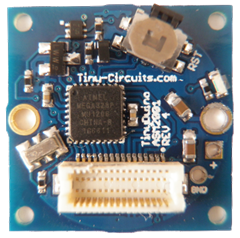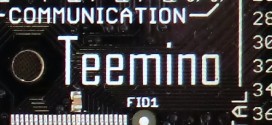 When I was contacted a little while ago by Ken Burns of the TinyDuino project, I thought: “Oh here we go, another Arduino clone project.” However, when I checked out the Kickstarter project I quickly went from “meh” to “WOW”.
When I was contacted a little while ago by Ken Burns of the TinyDuino project, I thought: “Oh here we go, another Arduino clone project.” However, when I checked out the Kickstarter project I quickly went from “meh” to “WOW”.
The TinyDuino is, well, tiny and by tiny, I mean really tiny. The Image on the left is the main board. It measures a whopping 20×20 mm. That’s smaller than most postage stamps and smaller than a 2 Euro coin. As with most *Duinos, it has shields. Naturally, these shields are tiny as well and connect to the main board using that white connector you see on the board. They can stack just like normal Arduinos. There are so many boards out now and being developed, it’s not even funny:
In production:
- TinyDuino Processor Board
- TinyShield USB & ICP
- TinyShield 16 Edge LEDs
- TinyShield Proto Board 1
- TinyShield Proto Board 2
- TinyShield Proto Board 3
Under development:
- Power Supply TinyShield (for 3.3V and 5.0V from 7 – 19V in)
- microSD card TinyShield
- RS-232 TinyShield
- Motor Driver TinyShield (several variations)
- More LED TinyShields
- OLED display board
- GPS TinyShield
- Bluetooth TinyShield
- WiFi TinyShield
- 802.15.4 TinyShield
If square is not for you, then you’re in luck, the board and shields are also available in a round shape. You can sort of make out the roundness of the circuit if you look at the picture. Basically, the round ones have the excess circuit board cut off. It does mean no mounting holes, though, so it may not always be as practical for attaching to your robot.
One of my first questions was “That’s nice, but does it run ROBOTC?” The answer is “nyes”. They are capable of it, but are configured to run at 8MHz to allow them to run at 3v3. This makes it possible to use a coin cell battery. As soon as you go to 16MHz, which is what ROBOTC requires, you need to increase the voltage, negating the ability to use that coin cell battery option. However, they’re going to do some testing with the 16MHz ones and told me they’d let me know if they had any luck running ROBOTC on it.
Below is a cool video of the creator pitching his TinyDuino idea. It’s really worth watching.
 Bot Bench I'd Rather Be Building Robots
Bot Bench I'd Rather Be Building Robots



Hi Xander,
there is also the FemtoDuino: even a tiny bit smaller (http://www.femtoduino.com/spex/femtoduino-usb, http://www.varesano.net/projects/hardware/Femtoduino).
Cool is that with these form-factors we can make cool/smart sensors and connect them to the NXT or EV3.
Best regards
What is this? An Arduino for ants? That thing is super tiny, wow!